February 19, 2010
Air Date: February 19, 2010
FULL SHOW
SEGMENTS
Climate Chief Calls it Quits
View the page for this story
Yvo de Boer, the Executive Secretary for the United Nations Framework Convention on Climate Change, has announced his resignation. Host Jeff Young talks with Bill Hare of the Potsdam Institute for Climate Impact Research about what this change in leadership will mean for climate negotiations. (06:00)
Ghost Filibuster Haunts Climate Action
View the page for this story
Read-your-grandma's-chicken-recipe filibusters no longer hold the Senate floor, but their threat routinely holds up plans to legislate ambitious action on problems like climate change. Lawyer Tom Geoghegan is a self-described contrarian. He tells host Jeff Young that the 60-vote supermajority required to stop a filibuster is undemocratic and bad for the planet. (06:00)
Pika in Peril
View the page for this story
Pika, an alpine cousin to the rabbit, are disappearing from parts of the Western United States, but the U.S. Fish and Wildlife Service declined to list the animal on the endangered species list. Host Jeff Young talks to Vermont Law School Professor Pat Parenteau about what this decision says about the Obama administration and endangered species protection. (06:35)
Endangered Frogs Face New Threats
/ Ashley AhearnView the page for this story
The California red-legged frogs miraculously survived fires that burned the hills outside of Los Angeles for five weeks last fall. But scientists now fear the threatened species may not have escaped from the recent heavy rains and mudslides. Producer Ashley Ahearn heads to the Angeles National Forest with a team of ecologists to search for the red-legged frogs. (07:00)
Urban Jungle Monkey
/ Bobby BascombView the page for this story
Manaus, Brazil is a city of two million people completely surrounded by the Amazon rainforest. Living on Earth’s Bobby Bascomb reports on a species of monkey found nowhere else in the world who are making themselves at home in the urban jungle. (03:20)
Fishing for Facts on Fish Food
/ Bridget MacdonaldView the page for this story
Many listeners were curious about the impacts of feeding chicken to fish in a recent aquaculture story. Living on Earth’s Bridget Macdonald dredges up some answers on the real chicken of the sea. (02:15)
One Fish, Two Fish, Farmed Fish, Barley Fish
View the page for this story
Each year, wild fish are caught by the thousands and turned into fishmeal to feed farmed fish. But wild fish populations are already stressed as the culinary demand for fish is on the rise, so researchers are looking for a fishmeal substitute. Host Jeff Young talks with Dr. Rick Barrows, a USDA fish physiologist about a promising alternative. (04:00)
Hard as Sea Snails
/ Emily GuerinView the page for this story
Researchers believe that better body and vehicle armor could be modeled on the shell of the scaly-foot snail, a tiny gastropod that lives on the floor of the Indian Ocean. Emily Guerin reports. (01:45)
The Battle to Blend in
View the page for this story
Scientists have long been intrigued by mimicry. Mimics adopt other animals’ colors to ward off predators, or take on the color and shape of their surroundings to avoid being seen. Artists have also noticed animals’ impressive disguises. Peter Forbes, author of the new book, Dazzled and Deceived: Mimicry and Camouflage, tells host Jeff Young how both artists and scientists tried to convince British military officials to adopt camouflage by disguising armies and battleships with tried and true methods from the natural world. (08:55)
Show Credits and Funders
Show Transcript
HOST: Jeff Young
GUESTS: Bill Hare, Tom Geoghegan, Pat Parenteau, Rick Barrows, Peter Forbes
REPORTERS: Ashley Ahearn, Bobby Bascomb, Bridget McDonald
SCIENCE NOTE: Emily Guerin
[THEME]
YOUNG: From Public Radio International - this is Living on Earth. I’m Jeff Young. A high-level resignation casts a cloud over the UN effort to contain climate change.
HARE: I think we’re in a period of at least grave uncertainty and I think it’s a bit of a shock now that someone with so much experience is actually leaving the system at a time when it needs to be stabilized.
YOUNG: What Yvo de Boer’s departure means for a climate change treaty. Also, how to save a critically endangered frog, when its habitat is hit first by fire, then by rain.
BACKLIN: The big concern is the fact that the whole watershed burned and we’re going to have these mudflows and flooding and how the frogs are going to cope with that.
YOUNG: And we assess how the Obama Administration is dealing with species threatened by a warming planet. These stories and more this week on Living on Earth. Stay with us!
[THEME]
ANNOUNCER: Support for Living on Earth comes from The National Science Foundation and Stonyfield Farm.
Climate Chief Calls it Quits

Soon-to-be former U.N. Climate Chief, Yvo DeBoer (Courtesy of the United Nations Climate Change Conference)
YOUNG: From the Jennifer and Ted Stanley Studios in Somerville, Massachusetts – this is Living on Earth. I’m Jeff Young. A top United Nations official on climate change calls it quits after four years, and that’s raising concerns about the worldwide effort to rein in global warming. Yvo de Boer says he’s resigning as Executive Secretary of the UN Framework Convention on Climate Change, where he fought hard for an international agreement to limit greenhouse gas emissions. In December, De Boer told Living on Earth he was optimistic about the big climate conference in Copenhagen.
DE BOER: What I want to see at the end of this conference is a list of rich country targets, that are ambitious, clarity on what major developing countries will do to limit the growth of their emissions, and a list of financial pledges that will make it possible for the much broader developing nation community both to change the direction of their economic growth and adapt to the inevitable impacts of climate change.
YOUNG: But Copenhagen brought only limited progress, and De Boer expressed disappointment. Physicist and climate scientist Bill Hare has watched Mr. De Boer’s work for years. He’s a visiting scientist at the Potsdam Institute for climate impact research. Mr. Hare says Mr. De Boer was squeezed between big economies like the U.S. and Europe and developing nations like China and India.
HARE: In the last year particularly he’s been under enormous pressure because of the pressures of trying to get under adverse political circumstances an ambitious agreement in Copenhagen, and because of the need to sometimes speak plainly about the level of ambition coming forth from major countries, which I’m sure many saw as going somewhat beyond the role of a UN diplomat.
YOUNG: He seemed to me at times like a man who was the equivalent of a rope in a tug of war with developing nations and developed nations on either end there.
HARE: Well, that’s right, I mean anyone in that position is going to be subject to powerful forces pulling in completely opposite directions, and I think it’s a tribute to his skills that he was able to keep the whole show together for so long. Personally, I think Copenhagen was a real mess, but I think that could have been a lot worse without the efforts of Yvo De Boer and the UN FCCC Secretariat.
YOUNG: Do we know was Mr. De Boer asked or forced to leave or did he leave of his own accord?
HARE: I’ve got no information about that, of course we all know and have heard about pressures upon the executive secretary in the last year from big countries who were reported to be unhappy with his forthright statements calling for greater levels of ambition, for more action domestically, for greater levels of political will and compromise to be brought in to national negotiations.
Publicly, Saudi Arabia criticized Yvo De Boer; we know that China was unhappy with him at different moments; rumors circulated that even the United States was unhappy with him over certain statements and certainly other countries were, as well. So, of course there’s no hard evidence on many of these rumors, but it’s somehow clear that where there was smoke there was fire and there were pressure on the Secretary, which is I guess only natural in a year like Copenhagen where there was enormous bit of government attention on a high-level meeting, which in the end failed to achieve that much.
YOUNG: What does this tell us, then, about the state of this framework convention on climate change process?

Soon-to-be former U.N. Climate Chief, Yvo DeBoer (Courtesy of the United Nations Climate Change Conference)
HARE: I think we’re in a period of at lease grave uncertainty and I think it’s a bit of a shock now that someone with so much experience is actually leaving the system at a time when it needs to be stabilized.
YOUNG: What can we expect now in the lead up to the next major round of talks in Mexico in Cancun?
HARE: It’s extremely difficult to make any reasonable prediction about just what we can expect to achieve at Cancun in Mexico, and I’m resiling from offering opinions about that. I think it’s still too early to say exactly what shape the regime is going to be in and therefore what will be possible to negotiate in the coming ten months.
YOUNG: Give me a sense of the bigger picture here, I mean this isn’t just about Mr. De Boer leaving, this isn’t just about the UN FCCC Process. The IPCC – the Intergovernmental Panel on Climate Change – the noble-winning scientific body is under serious attack. Climate change legislation in the U.S. is, at best, stalled. Are the wheels coming off of the whole effort to address climate change here?
HARE: Well, certainly the wheels are loose and I think I believe the system is in grave danger of collapsing. I think the IPCC – the Intergovernmental Panel on Climate Change – will survive the attacks of the skeptics, and let’s face it in a report of its size in magnitude one will always find errors. The remarkable thing is that the Intergovernmental Panel on Climate Change’s report’s have not suffered more attacks. I think the report’s standing up very well to the test of time in nearly all of its dimensions.
YOUNG: How much of the difficulty with the UN process comes back to difficulty getting something done in the U.S.?
HARE: I think the inability of the United States to bring its domestic legislation to a conclusion is casting a shadow over the whole international regime. I fear that unless the United States is able to bring itself to adopt a domestic climate package that has real meaning and action that it will be very difficult if not impossible to bring China and other big developing countries to the table to negotiate a legally binding and ambitious international climate regime.
YOUNG: Bill Hare, visiting scientist at the Potsdam Institute for climate impact research. Thank you very much.
HARE: Thank you.
Related link:
UNFCCC
Ghost Filibuster Haunts Climate Action

Strom Thurmond spoke for twenty-four hours and eighteen minutes during a filibuster against passage of the Civil Rights Act of 1957. (Courtesy of the Strom Thurmond Institute.)
YOUNG: Now, perhaps the biggest hurdle to U.S. and international action on climate change is in the U.S. Senate. Senate supporters of a cap on carbon emissions can’t get the votes to overcome a filibuster. The filibuster is an odd tradition in American politics, romanticized by Jimmy Stewart in Frank Capra’s classic, “Mr. Smith Goes to Washington”.
STEWART: And I’m gonna stay right here and fight for this lost cause even if this rooms gets filled with lies like these… somebody will listen to me, some—(collapse, scream).
YOUNG: That was then – today, arcane rule changes mean that it takes a supermajority of 60 votes to move just about any major bill through the Senate. Thomas Geoghegan calls that a “ghost filibuster” and says it’s blocking progress on problems like climate change. Mr. Geoghegan’s a Chicago lawyer and author who made his own run or Congress as a progressive Democrat. His latest campaign is against the filibuster.
GEOGHEGAN: Jimmy Stewart would be against the filibuster as it's practiced today because there’s no talking filibuster anymore in which you read your grandmother’s chicken recipe, and you brought out the cots, and you stayed all night in the Senate. In the 1970’s the filibuster was reformed and revised so it only took 60 votes and democratic leaders allowed the opposition to filibuster by saying that they would like to filibuster, but not actually going through the motions of shutting down the Senate in the hysterical way that Jimmy Stewart does in the clip.

Jimmy Stewart as Senator Smith in his last minutes on the Senate floor.
And, you know, Jimmy Stewart wasn’t arguing for a supermajority, he tried to get the country to rally around him – that’s not what it’s being used for anymore, it’s not being used for voice – nobody’s talking! It’s to simply shut down the ability of the majority to govern. So, that today, we’re suddenly in this 60-40-vote regimen, which is a modern development not part of the history of this country and not in the constitution.
YOUNG: What is this filibuster, as it is now, this supermajority requirement for everything – what does that mean for legislation on climate change?
GEOGHEGAN: It means we aren’t going to have any. As long as there’s a supermajority rule, and you know, the 40 Senators from the 20 smallest states in this country represent a population base of 11 percent. Potentially, you could have a measure designed to save the planet that is really stopped by 11 percent of the population of the country.
And there is a real serious question whether states like Montana, Utah, North Dakota, South Dakota ought to have a veto on things that are going to affect people in the sub-Sahara, in South America, in Europe. It would be an odd fate for planet Earth to go down the drain because developers in Montana don’t particularly like CO2 emission legislation.
YOUNG: Why shouldn’t something as important as addressing climate change, and let’s face it, dramatically altering our whole system of getting energy – why shouldn’t that require a supermajority?
GEOGHEGAN: Well, as Hamilton in Federalist No. 75 said, the history of every political establishment in which the supermajority has prevailed has a history of impotence, perplexity, and disorder. We can’t have government govern unless we have a government capable of acting based on majority rule. And it’s not just climate change. I can’t think of an environmental issue where the filibuster rule isn’t toxic to what environmental groups want to achieve.
YOUNG: I can think of some instances where the filibuster was championed as a way to gain environmental protection. We’d probably be drilling for oil in the Arctic National Wildlife Refuge now if not for filibuster that stopped that action.
GEOGHEGAN: Well, filibusters have stopped all sorts of terrible things, but filibusters discredit, in particular, progressive administrations that are committed to environmental quality. And when those progressive administrations are thrown out, discredited by the filibuster, low and behold people on the progressive left say, how wonderful the filibuster is because now we have it to stop the administration that got in because our own policies were discredited by the filibuster. It makes no sense.
That’s why we have two United States that show up at Copenhagen. The one United States is the United States that is concerned about global warming. And then there is the faux, or virtual United States as represented by the Senate where North Dakota has the same votes as California, and that United States seems bizarrely out of sync with the real United States; unconcerned about the issue, focused on developing western mining rights, and just not clued-in to what’s happening on the planet. It’s just frightening!

Strom Thurmond spoke for twenty-four hours and eighteen minutes during a filibuster against passage of the Civil Rights Act of 1957. (Courtesy of the Strom Thurmond Institute.)
YOUNG: You know, I do recall though that it wasn’t that long ago – the early 70s – when landmark environmental legislation passed with broad majority support from both parties.
GEOGHEGAN: Sure, of course. There was no filibuster rule. And generally the country was just much more liberal then. And the country was more liberal then because there was majority rule in the Senate with the look of a great society. It could never happen today with the filibuster. So when these laws were passed – civil rights laws, Medicare, and so forth – laws that couldn’t be passed today, they changed the culture of the country. The country moved in a more progressive direction.
YOUNG: Well, what do you think would happen if filibusters had to be good-old-fashioned filibusters?
GEOGHEGAN: Well, I’m all in favor of that. If this is a rule of obstruction then let them obstruct. If they want to shut down the administration, let them shut down the Senate. Let them see the Senate debate for three months though – I mean people would get disgusted very fast. The only reason the filibuster is so effective right now is that nobody ever filibusters.
If this country were aware as to how the invisible procedural filibuster process really works, we’d get rid of it overnight. The one thing that is keeping it in place is that not one Senator feels any heat from this issue and as long as they feel no heat I can assure this audience that the planet’s going to continue heating up.
YOUNG: Lawyer and progressive democrat Tom Geoghegan, thanks very much.
GEOGHEGAN: You're welcome.
[MUSIC: Medeski, Martin & Wood “Muchas Gracis” from Radiolarians 1 (Indirecto Records 2008)]
YOUNG: Just ahead – we look at the Obama administration’s record on the Endangered Species Act – keep listening to Living on Earth!
Pika in Peril
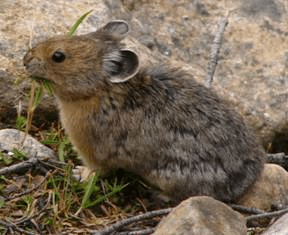
The American Pika live in rocky mountainous areas. The mammals don’t hibernate; instead they forage in the summer and make hay to eat over the winter months. (Photo: National Park Service)
YOUNG: It’s Living on Earth, I’m Jeff Young.
[SOUNDS OF PIKA – SQUEAKING EEEEK]
YOUNG: That’s the sound of the pika, a smallish rodent similar to the chinchilla that’s found throughout the Rocky Mountains from New Mexico to Canada. The pika needs a cool environment. In its southern range it’s found only above 8,000 feet. And there are concerns that a warming climate could push the pika first into smaller, higher habitats and eventually into extinction.
However, the U.S. Fish and Wildlife Service recently declined to include the pika on the nation’s list of threatened and endangered species. It’s just one of many controversial calls the Obama administration has made about species that might be threatened by climate change – like the polar bear.
Environmental law professor Pat Parenteau at the Vermont Law School helps keep us informed on endangered species issues. Prof. Parenteau, welcome back.
PARENTEAU: Thank you, pleasure to be here.
YOUNG: Now, why did Fish and Wildlife Service decline to list this animal, the pika, on the Endangered and Threatened Species list?
PARENTEAU: Basically, the Fish and Wildlife Service determined that because there are many places in the west where there are pika populations that the loss of some portion of the pika’s range and the reduction of habitat in some parts of its range was not enough to justify listing the pika.
YOUNG: Now, last time you and I talked about endangered species and climate change this was one animal you thought would get listing, right, the pika?
PARENTEAU: That’s right. I got proven wrong again when using my crystal ball. My basis for believing that they would go ahead with the listing is that in the case of the polar bear, the decision was that if climate change goes unchecked during the course of this century we’re going to lose the ice cover in the Arctic, and of course, we’re seeing that process unfold even now. And therefore, they made a very long-range projection that the polar bear probably couldn’t survive the loss of all this ice in the Arctic.

Pat Parenteau is a professor of environmental law at the Vermont Law School. (Courtesy of Vermont Law School)
So when you look at the pika, which is a species of mammal, it’s sometimes referred to as the boulder bunny, it’s like a little rabbit, and it lives in a very tiny ecological niche high in the alpine areas of the Rocky Mountains, the Sierra Nevadas, and other mountain areas in the west. And the same process of the loss of its habitat is unfolding. We’ve seen populations of pika disappear. For example, in the Great Basin area of the west, five mountain ranges have seen a loss of almost 40 percent of the pika from those areas, so we know, and the Fish and Wildlife Service acknowledged, that the pika is losing ground to climate change. And I was surprised that given that fact the Fish and Wildlife Service would not have erred on the side of caution and gone ahead and listed the pika, but they didn’t do that.
YOUNG: Well, if it’s any consolation you weren’t the only one who thought that they would list this – the group that sought the petition here, the Center for Biological Diversity, issued a statement after the decision saying, “this is a political decision that ignores science and the law.” What do you make of that statement; do you see any evidence to support that?
PARENTEAU: I think that’s probably too strong in terms of ignoring the science. The decision the Service made took into account all of the available science on climate change, but I do agree that there’s a serious question about whether the Service follow the requirements of the Endangered Species Act.

The American Pika live in rocky mountainous areas. The mammals don’t hibernate; instead they forage in the summer and make hay to eat over the winter months. (Photo: National Park Service)
They’re taking an approach which says the species has to basically prove it’s entitled to the protections of the Act, whereas I think the Act was really designed to be the reverse – to put a thumb on the scale, if you will, to protect the species where you’re not positive or certain that it’s at risk, but there’s enough evidence to justify taking a more precautionary approach.
The existing science clearly supports listing the species. They opted instead to say there are aspects of this species’ survival and biology that may enable it to survive even the threats – serious threats – from climate change. They took a narrow and somewhat conservative view of what the science was saying about the threats to this species and decided not to give it protection.
YOUNG: So what does this tell us about the Obama administration’s general attitude toward endangered species?
PARENTEAU: Well, we knew right off the bat with the polar bear listing when the Obama administration followed the lead of the previous Bush administration by saying that the Endangered Species Act was not intended to be used to address the causes of climate change, namely greenhouse gas sources. We knew from that point that this administration really was reluctant to use the Endangered Species Act in that way.
I think that pika decision is further evidence of that, so I’d have to say it appears as if the Obama administration is putting all of its chips on getting climate legislation through the Congress, and of course that’s a very speculative proposition at this point. And the unfortunate thing I think from the standpoint of species that are already experiencing impacts from climate change is that there really is no other statutory mechanism that we have, no law on the books that provides any protection for them, so not to use the one tool we do have strikes me as not a very sound policy.
YOUNG: So if the thinking is this is not an appropriate use of the Endangered Species Act to address climate change, well, then what do you do about these animals where that’s the primary threat?
PARENTEAU: That’s a very good question, and my answer to that would be I don’t see another tool that’s available under the law that could possibly provide protection for this kind of a species. There really isn’t any other threat to this species of any significance. It would be doing fine but for climate change.
And the fact of the matter is we have no effective regulation on greenhouse gas emissions and we do not know when – if ever – we will get such a regulation. So, the only thing that can be done in the meantime is to use existing tools like the Endangered Species Act, the National Environmental Policy Act, the Clean Air Act. These are old tools, it’s true, and they’re not adequate to deal with all the entire threat of climate change, but we have to use the tools we have – it’s all we have at our disposal.
YOUNG: Pat Parenteau, environmental law professor at the Vermont Law School. Thanks very much.
PARENTEAU: Thank you, Jeff.
Watch a day in the life of a pika.
Related links:
- Learn more about Pat Parenteau
- Center for Biological Diversity on the Pika
Endangered Frogs Face New Threats
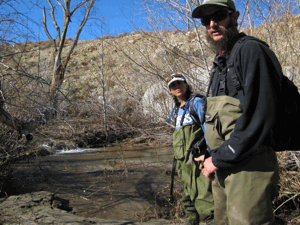
Backlin and Gallegos stand before what was once a rich habitat for frogs. Now, rushing water has destroyed the quiet creek. (Photo: Ashley Ahearn)
YOUNG: Well another endangered species story is unfolding in the hills of southern California. You remember those huge fires last fall just outside Los Angeles – two firefighters were killed and nearly ninety homes lost. But amid the ashes and blackened stumps, one good-news story emerged. While assessing the ecological damage, biologists stumbled upon a creek teeming with about 300 of the most endangered frogs in the state – the red-legged frog.
The excitement soon turned to fear when heavy rains hit the area and mudslides threatened the frog’s fragile hideout. Ashley Ahearn headed into the Angeles National Forest with a team of researchers to find out if the frogs can bounce back.
[TRUCK PASSING, RUSTLING AROUND IN TRUCK, GATHERING SUPPLIES]
AHEARN: On a dusty road on the northern side of the Angeles National Forest, Adam Backlin rustles around in the back of his SUV. Backlin, an ecologist with the U.S. Geological Survey, grabs his gear and wiggles into a pair of waders.
BACKLIN: I don’t know how to describe it. They’re not the most comfortable things in the world.
AHEARN: Backlin is ready to go frog hunting. But the frogs he’s looking for here aren’t easy to find.
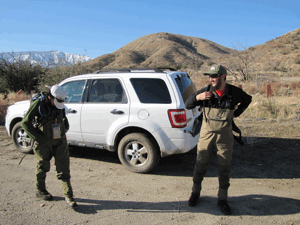
Adam Backlin and Liz Gallegos, both ecologists with the U.S. Geological Survey, get ready to go frog hunting. (Photo: Ashley Ahearn)
BACKLIN: The red-legged frog is a federally threatened species. It’s been declining across its range for the past two or three decades. It’s probably declined somewhere between 80 and 90 percent from where it historically used to occupy to its current status now, throughout its range.
AHEARN: Red-legged frogs are among the largest frogs west of the Mississippi. They’re about the size of a child’s baseball glove with crimson dappled legs and bulging yellow and black eyes. These frogs used to line the creeks and canyons of California. But as development in the southern part of the state ramped up, red-legged frog populations went down. At one point there were just about 40 left in the region. So Backlin and his colleague Liz Gallegos are excited about checking out the new population of about 300 red-leggeds that was discovered here recently.
[WADERS WALKING ON CEMENT. Liz: “You have the GPS”]
AHEARN: Today they plan to assess the damage in the burn area after recent heavy rains.
BACKLIN: The big concern is the fact that the whole watershed burned and we’re going to have these mudflows and flooding and how the frogs are going to cope with that.
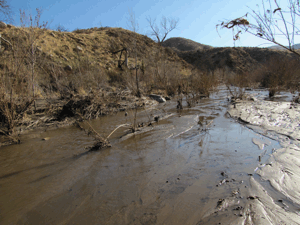
Mudslides fill mountain creeks with sediment and ash from the surrounding hillsides after heavy rains. (Photo: Ashley Ahearn)
[BOOTS WALKING]
BACKLIN: We’re going to drop down into the canyon here and get in the creek.
[CRACKLING BRUSH]
[WATER GURGLING SOUNDS]
BACKLIN: Wow. It’s a mud slick.
AHEARN: Backlin’s shoulders slump as he looks out over what used to be a rocky creek, flowing slowly through deep pools lined with cattails and shrubs – perfect habitat for frogs.
[WATER GURGLING SOUNDS]
BACKLIN: And what it looks like now is there’s a lot of sand and a lot of sediment and it just basically looks like a sandy wash with a kind of braided channel on top of it, which is not good for red-legged frogs. They don’t prefer this kind of habitat.
AHEARN: Here in Aliso Creek, Backlin and Gallegos test water quality, take pictures, and record water and air temperatures. We don’t find any frogs or egg sacks in this part of the creek but both ecologists are holding out hope for frogs as we move upstream.
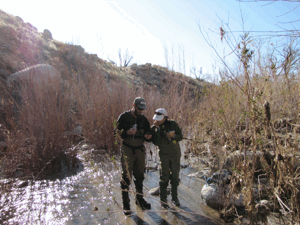
Backlin and Gallegos take water quality samples in Aliso Creek while looking for threatened red-legged frogs. (Photo: Ashley Ahearn)
BACKLIN: So up ahead you’ll see there are some places that had some really large pools and the adult frogs will congregate in those areas for the summer when they’re active and they’ll probably use those pools for breeding, and those are the pools that we’re going to be really interested in seeing how much of the sediment has been deposited in there. And if the pools are actually still pools or if the creek is going to look like this where there used to be pools.
[BOOTS WALKING IN WATER, RUSHING WATER FADES UP]
AHEARN: About 500 yards up stream from the first stop, we round a bend to the sound of rushing water. A mini-waterfall gushes over a flat stretch of sand and mud – no sign of the large rocky pools Backlin described.
GALLEGOS: Wow. That’s terrible. Wow.
AHEARN: Both ecologists look crestfallen. Backlin remembers this site from when the red-legged frogs were first discovered here soon after the fire stopped burning.
BACKLIN: In this pool I think we probably captured five or six adult red-legged frogs and detected another ten maybe that we weren’t able to catch because the pool was so big and it was really good for red-legged frogs. It did exactly what they needed to do where they could get away and hide from predators or biologists.
AHEARN: Historically, fires in this region occurred every 60 to 100 years but now they're more frequent. When the surrounding vegetation burns, heavy metals that naturally concentrate in plants are released in the ash, mixing with rain and mud, and flowing into creeks like this one.

Backlin and Gallegos stand before what was once a rich habitat for frogs. Now, rushing water has destroyed the quiet creek.
(Photo: Ashley Ahearn)
BACKLIN: Anything from heavy metals to mercury, asbestos, different things and all of that combined can change the water chemistry quite a bit.
[FLOWING WATER]
BACKLIN: Conductivity is 570 – and are you taking the water temp off that meter or this one?
AHEARN: In creeks tested after fires in San Diego a few years ago, pH levels were as high as 11 – that’s about the same as bleach. But the chemicals after events like this are flushed downstream quickly, making it hard for biologists to assess just how they may affect frogs and other aquatic life. Backlin says the big problem for these frogs isn’t water quality, it’s habitat fragmentation. There are just three populations of red-legged frogs in this region. If the frogs here in Aliso Creek are killed by mudslides, it’s next to impossible for other frogs to move in and repopulate.
BACKLIN: There’s just too few left and they’re too far apart and so as we lose one, that population is then gone forever.
AHEARN: When the frogs were discovered here state and federal officials debated relocating them but couldn’t agree on a solution. Taking threatened amphibians from state protected land to federally protected or privately owned land involves a lengthy permitting process. When Backlin tried to get the LA or San Diego zoos to take the frogs, he ran into another problem.
The frogs in Aliso Creek were infected with Chytrid, a fungus that is killing amphibians around the world. Frogs can survive with the fungus, but the zoos wanted nothing to do with the infected frogs. As he looks out over the flat muddy creek, Backlin says these problems don’t matter much anymore.
BACKLIN: This was a really healthy strong red-legged frog population and it’s unlikely that it will continue to be like that. We haven’t seen any red-legged frogs today.
AHEARN: The ecologist hopes that at the very least, the lost Aliso Creek frogs will have helped pave the way for a speedier governmental response for other species that may one day need emergency management or relocation.
BACKLIN: It’s kind of a new thing and I think it stems from us as a group finally recognizing that we have these really rare species and they only occur in these fragmented colonies and if we don’t do something we’re just watching this species disappear and continue to decline. It’s a little frustrating in that respect but it’s a learning process. Hopefully, in the future this will go more smoothly and we’ll be able to help these populations persist.
[GURGLING WATER SOUNDS]
AHEARN: For Living on Earth, I’m Ashley Ahearn in the Angeles National Forest.
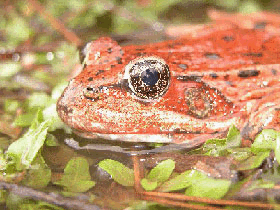
The California red-legged frog (Rana draytonii). (Photo: G. Fellers, USGS Western Ecological Research Center)
YOUNG: Now the California red-legged frog – rana draytonii to herpetologists – has another claim to fame. It’s probably – there’s some dispute, but probably the frog that Mark Twain immortalized in his short story “The Celebrated Jumping Frog of Calaveras County”.
In Twain’s story a frog, named Daniel Webster, is trained to be the best jumper around. But Daniel loses a jumping contest to another frog because a cheating gambler weighs poor Daniel down with buckshot. Twain was a master of satire but the true story of the red-legged frog is sadder. Bullfrogs – introduced by humans – have pushed the red-legged frogs out of some native habitat and once more the celebrated red-legged frog comes out the loser, but only because people keep tilting the playing field.
Related link:
California Red-legged Frog
[MUSIC: Mary Flower “Monkey’s On A Binge” from Instrumental Breakdown (Yellow Dog Records 2007)]
Urban Jungle Monkey
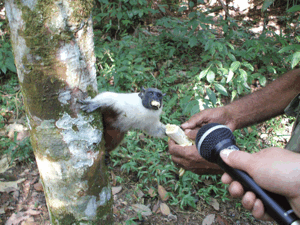
A Brazil Nut Saki enjoys a hand-fed mid-morning snack. (Photo: Marco Lima)
YOUNG: In the middle of the Amazon basin, the world’s largest rainforest, is the city of Manaus. And in the middle of the city of two million people live 112 very unusual residents, found no where else in the world. Living on Earth’s Bobby Bascomb reports.
[MANAUS CITY SOUNDS]
BASCOMB: Mindu is a slice of rainforest in the middle of a city. It’s the largest park in Manaus with 75 acres of thick vines and lush forest.
[MONKEY SOUNDS]
LIMA: You know this guy here, this is the most impressive one we have inside of a Brazilian town.
BASCOMB: Marco Lima is a Brazilian biologist. He watches a park naturalist feed finger-sized bananas to a group of white, brown and black monkeys.
[MONKEY EATING SOUND]

A Brazil Nut Saki enjoys a hand-fed mid-morning snack. (Photo: Marco Lima)
LIMA: That is the Brazil nut saki. It used to be called the saki from Manaus because it’s only found in Manaus.
[KISSING SOUND]
BASCOMB: There are about 130 different types of monkey in the Amazon. One third of those were discovered in the last 20 years. But Lima says the Brazil nut saki is unique.
LIMA: They are a small monkey with a very little tiny face, size of a small hand. But what do they have that’s really incredible is the size of their tail. They don’t use it to move around but they use it to make their jumps stable. This is something very different comparing them to all the other monkeys in the Amazon.
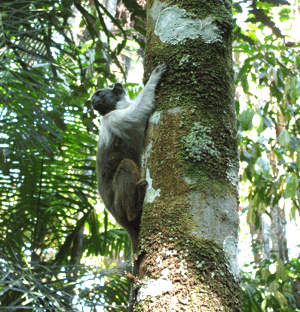
The Brazil Nut Saki is locally known as the Monkey from Manaus. (Photo: Bobby Bascomb)
BASCOMB: And unlike other monkeys in the jungle the sakis are urban dwellers. In the past two decades Manaus has grown dramatically. The monkeys managed to survive in relatively tiny pockets of forest as the city expanded around them. 112 of the endangered sakis now live in the city and Lima says there’s no going back to the jungle.
LIMA: In the Amazon we have many rivers. All the big rivers, they are natural biological walls. They isolate species. Many species cannot simply swim and say, oh let’s go to the other side of the river. Let’s buy a boat and cross the other side of the river. They don’t do that. So this isolates them.
[MONKEY SOUNDS]
LIMA: These places are nature pit stops for many species. Manaus is in a very strategic point because if you just cross the Amazon River from Manaus, pristine rainforest. Manaus it is a town of about 200 square miles and outside of it, beautiful nature. We need to remember that we are the second comers.
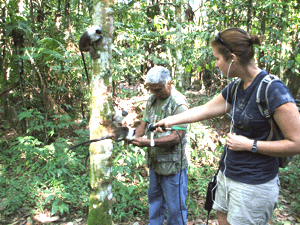
Living on Earth’s Bobby Bascomb records feeding time at Mindu Park. (Photo: Marco Lima)
BASCOMB: But the first residents of the forest, the football-sized Brazil nut sakis are thriving in their home in the urban jungle.
[MONKEY SOUNDS]
BASCOMB: Is that one with a baby up there? On that tree?
LIMA: Uh…yeah, it has a baby. (Portuguese) Yeah, it has a baby. Look at here - this is already a success of a place like this just to see life keep on going, you know.
[KISSING SOUNDS]
BASCOMB: For Living on Earth, I’m Bobby Bascomb in Manaus, Brazil.
[KISSING SOUNDS]
[MUSIC: C’eU “Close Your Eyes (Faze Action remix) from Tanto Tempo Remixes (Six Degrees Records 2009)]
YOUNG: Coming up: Casting about for better ways to feed the fish that will some day feed us. That’s just ahead on Living on Earth.
ANNOUNCER: Support for the environmental health desk at Living on Earth comes from The Cedar Tree Foundation. Support also comes from the Richard and Rhoda Goldman Fund for coverage of population and the environment. And from Gilman Ordway for coverage of environmental change. This is Living on Earth on PRI – Public Radio International.
Fishing for Facts on Fish Food
YOUNG: It’s Living on Earth, I’m Jeff Young.
[LETTERS THEME, TYPEWRITER SOUNDS]
YOUNG: Time to answer some questions from you. Quite a few listeners thought there was something a bit fishy in our recent story about farm-raised salmon. We heard about a new type of fish farming that got the seal of approval from the Monterey Bay Aquarium’s Seafood Watch Program.
The part that raised questions was the news that the feed for these fish will include chicken. Kay Klippel hears us on Amherst, Massachusetts station WFCR. She wrote, “Do you think feeding farmed salmon chicken pellets is progress? These aqua-farmers are just pushing the problem of where our food comes from back to land.”
Others wanted to know about the nutritional value of these chicken-fed-fish and whether they might be tainted by antibiotics or hormones. All good questions. So we sent Living on Earth’s Bridget Macdonald fishing for some answers:
MACDONALD: It’s not as appetizing as “chicken of the sea”, but meal made from fermented, ground up poultry feathers is a common ingredient in commercial fish food.
The owner of Aquaseed Corporation Per Heggelund said he buys a high-end commercial food for his Seafood Watch-approved salmon. It’s made primarily of vegetable proteins. But because the recipe is proprietary he conceded it might contain some feather meal as well. It’s also possible that any feather meal in the mix could be a byproduct of chicken farms that use hormones and antibiotics. But down the line, Heggelund said the company plans to phase out feather meal entirely.
When it comes to essential fatty acids, a researcher at the Harvard School of Public Health said farmed salmon typically contain twice as many Omega three’s as their wild cousins. That’s because a farm-raised salmon knows where its next meal is coming from, so uses less energy and stores more fat than a wild fish, which is always on the hunt.
No matter where their protein comes from, farm-raised salmon get their essential fats from fish oil supplements, not unlike the Cod liver oil capsules that many people take with their own meals. And there is no guarantee that supplements – whether you take them, or they’re fed to salmon – come from sustainable fisheries. I’m Bridget Macdonald.
Related link:
For more on plant-eating fish, click here.
One Fish, Two Fish, Farmed Fish, Barley Fish
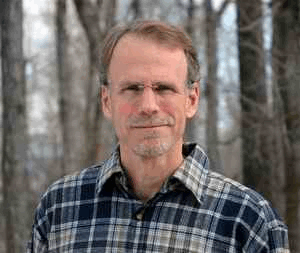
Rick Barrows
YOUNG: So the search is on for something better to feed farmed fish. Dr. Rick Barrows thinks he might have a candidate. He’s a fish physiologist with the USDA’s Agriculture Research Service. Dr. Barrows, welcome to Living on Earth.
BARROWS: Hi!
YOUNG: So, you’re looking for a new, effective fish feed? What have you come up with?
BARROWS: Well, one of the promising areas is barley protein concentrate. It’s similar to soy protein concentrate, which is used in human foods all the time, but it’s produced using a different method that results in the co-product production of bio-fuels. And we take the carbohydrate portion of the barley, we take that off to make ethanol and then what’s left over is this high quality, good amino acid profile protein that we can then feed to fish.
YOUNG: And why would this be a good choice to feed to farmed fish?
BARROWS: Part of it is availability; there is a lot of barley around right now with not a lot of demand. Barley also has very low anti-nutrient levels and a good nutrient profile. Anti-nutrients are substances in plants that basically evolved to keep other animals from eating them. And that can be a problem with some alternative sources, where barley doesn’t have that.
YOUNG: Now, most of the fish species that we are looking to here are carnivores – they eat other fish – so could a fish that normally eats other fish get by eating barley?
BARROWS: Yes because fish and other animals require nutrients, not ingredients. It’s really the nutrition out of the meal that they need. We have found over the last six years that there are several substances that are found in high levels of fish meal that aren’t found in plants, but when you feed a fish meal-free, all plant diet to carnivorous fish you need to supplement those nutrients, as well.

Rick Barrows
YOUNG: And would this produce a fish that would have the nutritional benefits that consumers are looking for?
BARROWS: Well, those benefits include high protein, which of course it will have, but the fatty acid profile, the heart healthy characteristics of fish that really comes from the oil source. So we still need to provide the fish with an energy source, which has been fish oil in the past, to get those same heart healthy benefits.
YOUNG: So if you have to supplement their feed here in order to get the high omega three, where do you get the fish oil, and is that carry risk of contaminating the fish?
BARROWS: Very good question. Right now the primary source of omega three fatty acids for fish is from fish oil, which is wild harvested – it will carry the PCBs – but the majority of fish oil that is fed to fish now is carbon-filtered to remove those PCBs.
YOUNG: And if this were to become a major part of how we feed farmed fish, would this improve the environmental impact of fish farming?
BARROWS: Yes, it can improve sustainability because we’re growing the food for the fish, rather than harvesting it from the sea. But it’s also – plants have a very low levels of phosphorous. Fish meal carries high levels of phosphorous with it, more than the fish require and so then you have lots of phosphorous going downstream from a fish farm; feeding plant-based diets you have much lower levels of phosphorous.
YOUNG: And would we have farmland sufficient to meet the demand if we go this route?
BARROWS: No, there isn’t going to be enough barley around to make barley protein concentrate for all farmed fish, but it could become another important tool in the tool box.
YOUNG: You’ve been in this business for quite a while, have you noticed an uptick in general interest here?
BARROWS: Yes, definitely. There’s a lot of concern over environmental pollution from fish farms, there’s a lot of concern over the sustainability of the fishmeal, there’s a lot of concern over PCB levels in farmed fish. Every system can be improved by critical evaluation, and that’s really what has been happening the last couple years and the industry’s responding and producing fish in a more sustainable fashion.
YOUNG: Fish physiologist Rick Barrows, thanks very much.
BARROWS: You’re welcome, nice talking with you.
[MUSIC: Lightnin Hopkins “Fishin Clothes” from Fishin Clothes Vol 1 (Great American Music 2008)]
Hard as Sea Snails
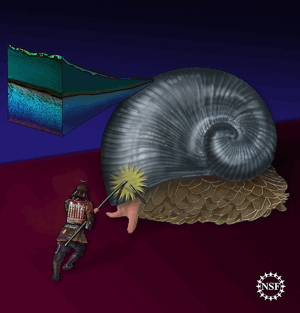
A soldier is deterred by the scaly-foot snail’s hard shell. (Image: Zina Deretsky, National Science Foundation)
YOUNG: Coming up – an author finds deep insight by looking at the ways animals hide. But first this Note on Emerging Science from Emily Guerin.
[SCIENCE NOTE THEME]
GUERIN: The scaly-foot snail was only discovered in 2001, but the deep-sea dweller has already made a big splash in the scientific world. Its super-hard shell has MIT researchers wondering if armor could be modeled on the tiny creature.
The snail lives 6,000 feet under the sea next to “black smokers,” sea-floor chimneys that spew superheated water from under the earth’s crust. The little gastropod must tolerate pressure of up to 4,400 pounds per inch and acidic water that can range from near freezing to a piping hot 750 degrees Fahrenheit. To top it off, the scaly-foot must ward off attacks from crabs and other snails.

A soldier is deterred by the scaly-foot snail’s hard shell. (Image: Zina Deretsky, National Science Foundation)
But the scaly-foot has adapted to its unwelcoming home. It sports a tri-layered shell that can take a predator days to break through. The thin outer layer, made of iron sulfide, is the strongest. When attacked, it develops tiny cracks, dissipating the energy and preventing larger cracks from forming.
The middle layer is spongy and shock resistant like a bike helmet, and may also absorb heat. The inner layer is made of calcium carbonate, a common shell material that would erode in the acidic water if not protected by the other layers.
Scientists believe the tiny scaly-foot snail could teach them a lot about structural engineering, and may one day inspire a new generation of body and vehicle armor. It’s a lot of pressure to put on such a small creature, but pressure is one thing this snail is used to. That’s this week’s Note on Emerging Science. I’m Emily Guerin.
[SCIENCE NOTE THEME]
Related link:
For more on the steely snail, click here.
The Battle to Blend in

A leaf mimic butterfly.
YOUNG: Now the scaly-foot snail’s not the only creature to inspire the military-minded. The Romans observed the tortoise and created the testudo – an ingenious method of overlapping shields to block incoming arrows and such.
Camouflage and mimicry in nature have long amazed and at times frustrated humans. Just how did the leaf like mantis or walking stick gain the ability to disappear before our eyes? And how does a benign butterfly manage to imitate its toxic cousins? Peter Forbes dives into those questions in his book “Dazzled and Deceived: Mimicry and Camouflage”. It’s a thorough history of the scientists and soldiers who tried to understand and apply some of nature’s best tricks. Hello, Mr. Forbes!
FORBES: Hi there.
YOUNG: So why mimicry and camouflage, what drew you to this subject?

A leaf mimic butterfly.
FORBES: Well the great thing about mimicry is that I mean sometimes in evolution you see some weird creature and you think, how did that evolve or why? But with mimicry the fact is you’ve got two things that look the same, so you see what must have happened; they gained some advantage that they hide that way. So in a sense they’re like artists, they see a pretty pattern and copying it.
YOUNG: This is a real challenge for evolutionary theory to explain how these things came to be.
FORBES: Well, it’s a challenge that it’s still running this challenge actually because there’s a lot of debate about the mechanisms of evolution, not about that it happened, but how does one creature get to look like another? You can see if one creature looks quite a lot like another and one creature’s dangerous, so predators leave it alone – the one that looks a bit like the other one will get to look more like it because the one’s that aren’t very good mimics will get picked up by predators. But the big problem is how does it start? And actually Darwin wrote his book 150 years ago and biologists are still arguing about exactly how does it start?
YOUNG: You know, I had one of these moments recently at the aquarium here in Boston with my daughter – we’re looking at the leafy sea dragon and I’m looking at that thing with all its baroque appendages and it’s such a perfect match and you just think, you can easily slip into this – gee, there must have been a design kind of thinking to that, and a lot of scientists fell into that trap. I noticed that throughout your book.
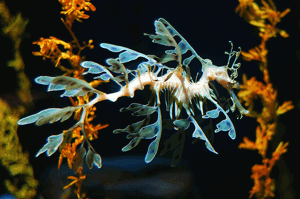
The leafy sea dragon. (Wikimedia Commons)
FORBES: Well, I don’t think – I’m glad you saw the leafy sea dragon, it’s one of my favorites, but I mean it really does look like seaweed. But I mean, why would anything get designed to look like seaweed? And the actual designer really is a seaweed and the dragon lives among them – I mean it is a predator, so it needs to hide so that the things that it eats can’t see it.
YOUNG: So this debate was kind of raging in science about the mechanisms that would produce mimicry and camouflage in animals, and then along come World War I and these scientists felt compelled, I guess to offer what they had learned from nature for the war effort?
FORBES: Yes, in the 1890s Albert Thayer and American artist and naturalist formulated some ideas about camouflage – counter-shading – and he communicated these ideas to some biologists in England. So when war started in 1914, they tried to tell the war department that in modern warfare you’re going to need camouflage, the weapons are bigger and stronger.
I mean in the old days, soldiers used to go into battle wearing red so that they could be identified, but once you got the machine gun this wasn’t a very good idea when you’ve got a machine gun firing at you. You need to hide, you need to hide your troops, and you need to hide your ships, you need to try to hide everything.
YOUNG: And was Mr. Thayer persuasive?
FORBES: Well, Thayer was an amazing character. He’s one of the central figures in my book, but Thayer was obsessed. He was obsessed that ships had to have all kinds of crazy ideas to camouflage them. In fact, he even suggested rigging them out so that they looked like clouds on the horizon, things like that. But unfortunately, in the first World War mostly the authorities didn’t listen to the naturalists, they actually did listen to an artist though.
YOUNG: So the naturalists were bringing what they thought were the best ideas for camouflage, but artists had their own ideas. How did that play out?
FORBES: There’s this story: Gertrude Stein was with Picasso when the war started and they saw some camouflage tanks coming down the street and Picasso said, “Cubism! That is cubism – we made that. We made camouflage.” Now, it wasn’t quite as simple as that, but there were painters in the French camouflage corps who were quite clearly influenced by cubism.
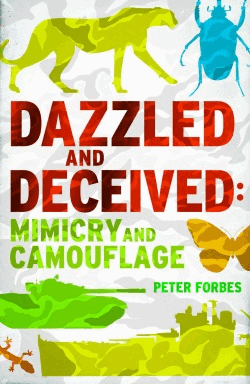
And in fact, more artists were involved early in the camouflage effort than naturalists. And the naturalists got rather aggrieved because they thought, look we discovered this first, we know how creatures who life – it’s life and death for them, whether they escape a predator, therefore, it must be relevant to human warfare. But the painters said, look we know all about how to break up forms and to hide things, we’re the experts in visual world, so trust us. So it was a kind of battle that went on between artists and naturalists.
YOUNG: And who won there in the World War I year?
FORBES: Well, in World War I, I guess you have to say that the artists won because an English artist called Norma Wilkinson came up with this idea of dazzle painting, which rather turned ships into kind of zebras. And this wasn’t to hide them because you said you can’t hide ships on the sea. It was to create a confusing jangle to confuse the range finders of periscopes of the submarines that were hunting them.
YOUNG: Did it end up doing any good – did it save boats from getting hit by u-boat torpedoes?
FORBES: I mean one month you’d see that the death of ships seemed to have a much better survival rate, then the next month you’d see it didn’t seem to be true. And actually when the war was over the navy authorities said in the future we won’t do dazzle. But as I say, although they started the second World War with grey ships, camouflage had started to come back again, but this time it was really the – it wasn’t dazzle – it actually was the naturalist’s idea of using soft tones and trying to counter the effect of light and shadow.
YOUNG: So the influence of naturalists in camouflage they really reached their peak in the desert in World War II?
FORBES: So, I think that battle in the desert, which is fantastically improvised, and of course it’s very hard to hide in the desert, this was the thing – you couldn’t really hide, but you could make one thing look like another. The Battle of El Alamein was a massive deception operation where they actually disguised the tanks as trucks.

Author Peter Forbes.
They actually created a dummy army in a place where they weren’t going to attack, they created a rail head, which was just made out of palm fronds, they put up dummy flares to attract the planes to this dummy railhead. You know, they even had locomotive that was smoking with dummy men around it. They used every trick in the book. That’s the high point of that kind of huge, huge scale camouflage that could only happen before the modern electronic era of warfare.
YOUNG: And the guy who was the main force behind this, very interesting guy, Cot. Is that his name?
FORBES: Yes, Hugh Cot was really the man in camouflage military, the naturalist in the mid-20th century. He wrote the classic book, which is still unsurpassed really. The strange thing is he joined the military and became a camouflage instructor and went to the desert and it must be the only big natural history tome that was ever packed into soldiers’ kit bags because it was the recommended reading that you had to learn from nature if you’re going to be a desert camouflor.
YOUNG: So you actually had soldiers carrying around this natural history textbook with them?
FORBES: Absolutely, and it’s quite a big book, yeah.
YOUNG: But it paid off because Montgomery was able to fool the desert fox, Rommel.
FORBES: Absolutely, yes. Churchill, himself, was very, very keen on camouflage activities, so the British approach was to actually use as much of this kind of deception as possible. And Hugh Cot was there as the brains behind the training of the camouflors in the desert.
YOUNG: You know, it’s pretty ironic here that the whole point of mimicry and camouflage is so that you can’t see it. And yet, by looking at it closely, we’ve gained great insight for decades and decades.
FORBES: Well, yes, absolutely. I mean, the whole business of trying to hide, or trying to be so like another creature that you get a quiet life because that creature’s so dangerous cause things leave it alone. And, yeah, by trying to hide some how or other, it’s a technique that for us we look at creatures that do this and we think, ah ha! This can tell us a lot about how nature works.
YOUNG: Well the book is jut fascinating. It’s called “Dazzled and Deceived: Mimicry and Camouflage”, Peter Forbes, thanks very much.
FORBES: Thank you.
Related link:
For more on Peter Forbes, click here.
ANNOUNCER: Funding for Living On Earth comes from the National Science Foundation supporting coverage of emerging science. And Stonyfield farm, organic yogurt and smoothies. Stonyfield pays its farmers not to use artificial growth hormones on their cows. Details at Stonyfield dot com. Support also comes from you, our listeners. The Ford Foundation, The Town Creek Foundation, The Oak Foundation—supporting coverage of climate change and marine issues. And Pax World Mutual Funds, integrating environmental, social, and governance factors into investment analysis and decision making. On the web at Pax world dot com. Pax World for tomorrow.
ANNOUNCER 2: PRI – Public Radio International
Living on Earth wants to hear from you!
Living on Earth
62 Calef Highway, Suite 212
Lee, NH 03861
Telephone: 617-287-4121
E-mail: comments@loe.org
Newsletter [Click here]
Donate to Living on Earth!
Living on Earth is an independent media program and relies entirely on contributions from listeners and institutions supporting public service. Please donate now to preserve an independent environmental voice.
NewsletterLiving on Earth offers a weekly delivery of the show's rundown to your mailbox. Sign up for our newsletter today!
 Sailors For The Sea: Be the change you want to sea.
Sailors For The Sea: Be the change you want to sea.
 The Grantham Foundation for the Protection of the Environment: Committed to protecting and improving the health of the global environment.
The Grantham Foundation for the Protection of the Environment: Committed to protecting and improving the health of the global environment.
 Contribute to Living on Earth and receive, as our gift to you, an archival print of one of Mark Seth Lender's extraordinary wildlife photographs. Follow the link to see Mark's current collection of photographs.
Contribute to Living on Earth and receive, as our gift to you, an archival print of one of Mark Seth Lender's extraordinary wildlife photographs. Follow the link to see Mark's current collection of photographs.
 Buy a signed copy of Mark Seth Lender's book Smeagull the Seagull & support Living on Earth
Buy a signed copy of Mark Seth Lender's book Smeagull the Seagull & support Living on Earth

